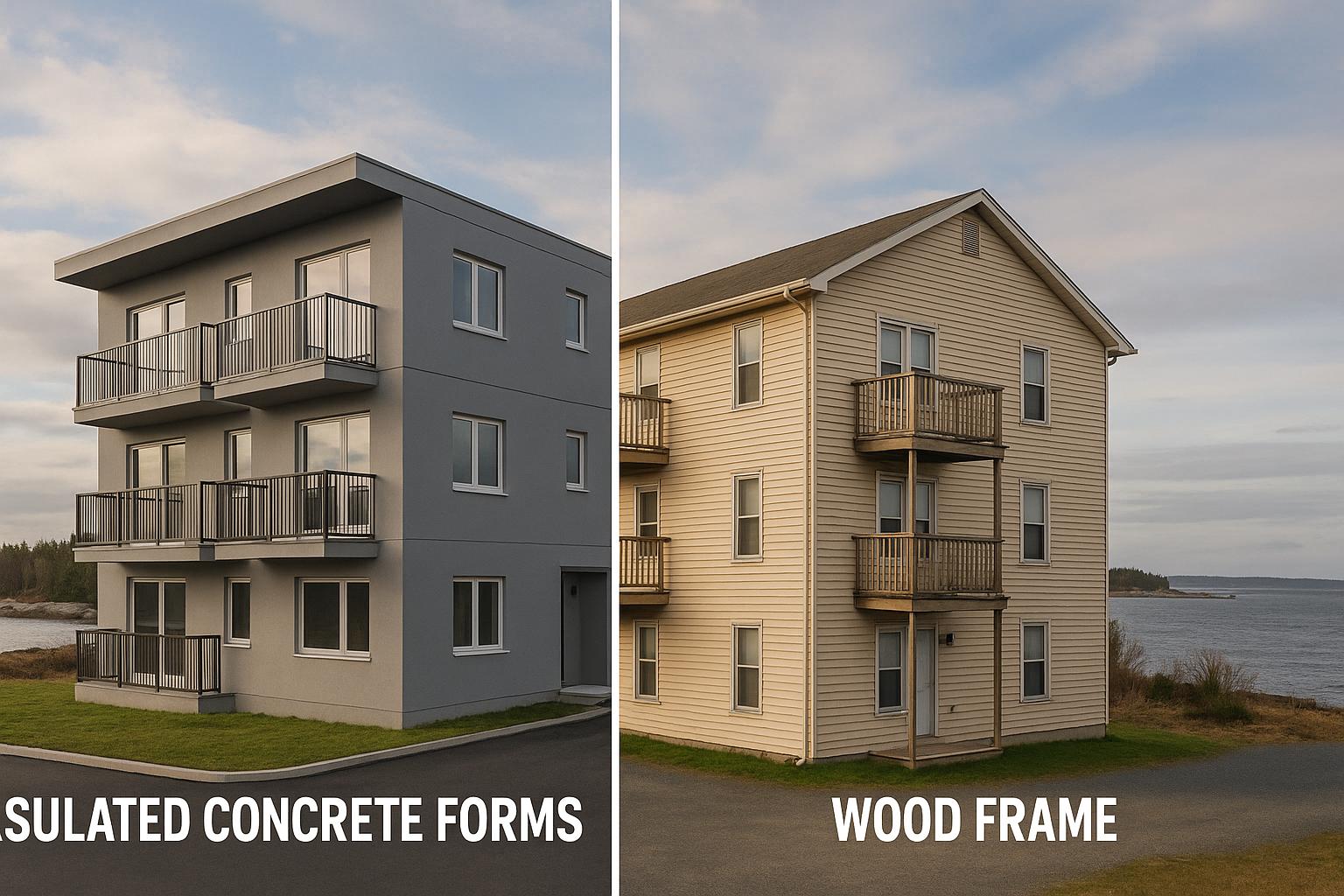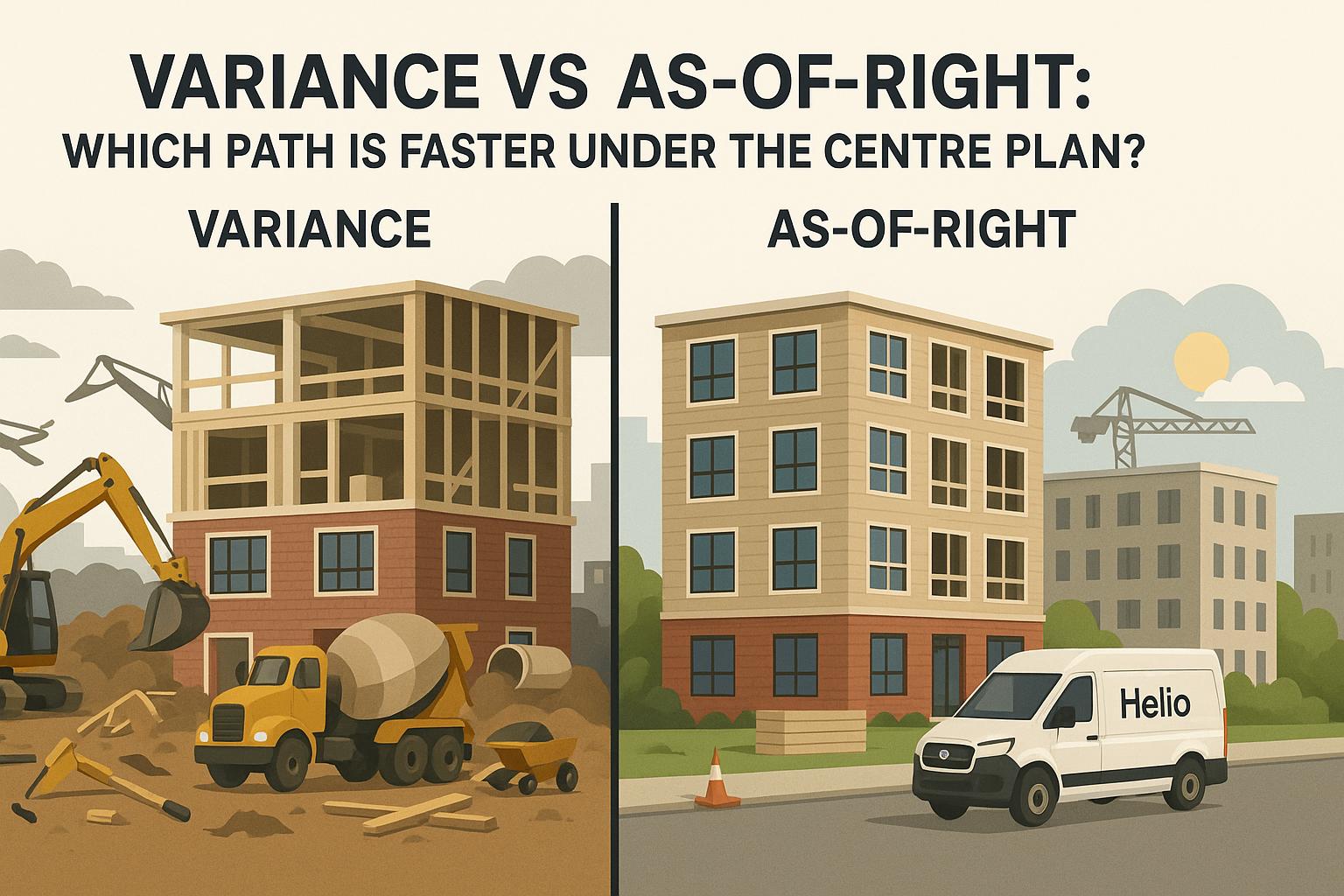When you're planning a 4+ unit rental property in Nova Scotia, fire access and municipal addressing are critical steps to secure building and occupancy permits. Delays in meeting these requirements can push back tenant move-ins and increase costs. Here's what you need to know:
- Fire Access: Emergency vehicles need clear, unobstructed routes. This includes proper road width, load capacity, hydrant placement, and vertical clearance. Address these early in your site design to avoid costly revisions.
- Municipal Addressing: Each unit must have a visible, compliant civic number to help emergency responders locate properties quickly. Numbers should meet specific size and visibility standards.
- Fire Safety Inspections: Inspectors review fire separations, escape routes, and alarm systems. Prepare by ensuring all systems and routes are functional, clear, and compliant.
- Fire Safety Plan: Multi-unit buildings require a detailed plan outlining emergency procedures and system maintenance. Halifax Regional Fire & Emergency offers templates to simplify this process.
To avoid delays, integrate fire safety and addressing requirements into your planning from the start. An integrated design-build approach can streamline compliance, reducing permit rejections and saving time. A two-month delay for a fourplex could cost $15,600–$16,800 in lost rental income - early preparation protects your timeline and investment.
Department of Permitting Services Podcast: Building Safety: Fire Department Access
Life-Safety Site Requirements in Nova Scotia
In Nova Scotia, life-safety site requirements are governed by strict regulations aimed at protecting residents and ensuring emergency responders can access multi-unit properties efficiently. For owners of multi-unit rental buildings, adhering to fire access and addressing standards is a must when applying for building permits. Knowing these rules can make the permitting process much smoother.
Regulations and Standards That Apply
The Nova Scotia Fire Safety Act and its associated regulations set the foundation for fire safety compliance in the province [1]. These regulations incorporate and adapt the National Fire Code of Canada 2020, making its guidelines enforceable for all construction and renovation projects in Nova Scotia [1]. For multi-unit rental properties, submitting sealed building plans to the Fire Marshal is mandatory before construction can begin [1].
Why Compliance Matters for Permits
Meeting these standards isn’t just a legal formality - it’s essential for getting your building permits approved. The Fire Marshal must review and approve your fire access and addressing plans before permits are issued [1]. Failure to provide compliant or complete plans can result in delays or even rejection of your application, adding unnecessary complications to your project.
Fire Department Access: Meeting Required Standards
When designing multi-unit rental properties, ensuring clear and unobstructed routes for emergency vehicles is non-negotiable. These access requirements are not just about compliance; they are critical for resident safety and can also streamline the permit approval process. Addressing these standards early in your planning can save time and effort down the line.
Fire Access Standards You Must Meet
Fire access routes must be designed to handle the size, weight, and manoeuvrability of emergency vehicles. While requirements can differ based on location, here are some key considerations:
- Road design: Ensure access roads can accommodate the width, turning radius, and weight of emergency vehicles.
- Load capacity: Use materials and construction methods that support heavy loads.
- Hydrant placement: Position fire hydrants within a suitable distance to provide effective coverage.
- Vertical clearance: Keep access routes free of overhead obstructions.
Since these specifications vary by municipality, it’s essential to consult your local fire department or governing authority for the most up-to-date guidelines.
Including Fire Access in Site Design
Incorporating fire access requirements at the start of your site design process can save you from costly changes later. Here’s how to approach it:
- Designate fire lanes: Clearly mark fire lanes in accordance with local regulations.
- Collaborate with experts: Work with engineers and designers to select materials that meet load requirements and ensure road layouts comply with turning and clearance needs.
- Address challenges: Solve potential issues like steep slopes or dead-end roads with turnaround areas or alternate connections.
- Plan for maintenance: Factor in ongoing needs like snow removal and surface repairs to keep emergency routes accessible year-round.
Submitting Fire Access Plans for Approval
Once your design meets all fire access standards, it’s time to prepare your submission for approval. A detailed and well-documented application can help avoid delays. Your submission should include:
- Site drawings: Clearly illustrate all fire access routes.
- Engineering reports: Provide supporting documents to validate design choices, if required.
- Municipal approvals: Include correspondence verifying hydrant placement and water supply adequacy.
- Construction sequencing: Outline how access will be maintained throughout development, including temporary arrangements during construction phases.
A complete and precise submission not only speeds up the permit review process but also ensures your project meets critical safety standards.
Municipal Addressing: Getting Clear and Compliant Site Addresses
Municipal addressing plays a crucial role in life safety, ensuring emergency responders can find your property quickly. This process is tied to your building permit application, so it’s wise to tackle these requirements early in your project planning.
How to Get and Assign Municipal Addresses
When applying for a building permit, the municipality evaluates your property’s addressing needs based on the proposed development. For multi-unit properties, a separate civic number (municipal address) is assigned during the application process, distinct from the main dwelling’s address [2]. These numbers are designed to fit into the existing street numbering system and support emergency services.
Your local municipal planning department is the go-to resource for addressing requirements. They’ll ensure the assigned civic numbers meet placement and visibility standards, keeping everything compliant and easy to locate.
Address Display Standards and Emergency Access
Properly displaying your civic number isn’t just a legal obligation - it’s critical for emergency response. Property owners must ensure that their assigned numbers are posted on all structures or facilities [3]. These numbers need to be visible year-round, both day and night [3][5][7].
To meet visibility standards, keep the following in mind:
- If your house is more than 30 metres (100 feet) from the road or hidden from view, post the civic number at the start of the driveway [3].
- Signs must be on the same side of the street or private road as the property and visible from both directions [4][6].
- Ensure the number is not obstructed from view when seen from the nearest travelled portion of the road [4].
- Civic numbers should always be displayed horizontally [4][6].
- Numbers must be illuminated at night for easy visibility [7].
Emergency responders depend on the logical placement of even and odd numbers. Avoid placing your civic number plate on the opposite side of the road from your property, as emergency vehicles look for even numbers on one side and odd numbers on the other [6].
These standards are especially important for properties with unique numbering needs, such as multi-unit buildings.
Addressing Requirements for Multi-Unit Properties
Multi-unit properties come with additional considerations. Each unit needs clear identification linked to the main civic address, creating a system that emergency responders can navigate without confusion.
The size and visibility of numbers are particularly important for multi-unit properties. For residential buildings, numbers must be at least 100 mm (4 inches) tall [3][4][5]. Non-residential properties require even larger numbers, with a minimum height of 200 mm (8 inches) [3]. If your property is on a private road serving multiple units, a road name sign is also essential for emergency response [6].
Some municipalities provide standardized address plates for a small fee - typically $14.00, plus $2.00 for postage [6]. Check with your local municipality to see if they offer a similar service.
Internal unit identification is another key requirement. While the municipal address applies to the overall property, a clear and logical numbering system is needed for individual units. This internal numbering must be easy to spot at common access points, ensuring emergency responders can locate specific units quickly.
sbb-itb-16b8a48
Preparing for Fire Safety Inspections and Avoiding Permit Delays
In Nova Scotia, fire safety inspections are a mandatory step for multi-unit properties. Being well-prepared can make the process smoother and help secure timely approval.
What Inspectors Look For
Fire inspectors evaluate several key areas to ensure life-safety compliance. One of the most critical aspects is fire separations. Inspectors assess whether floor assemblies and other key areas meet fire separation standards. They pay close attention to "fire separation continuity", ensuring there are no unprotected openings, no damage to fire-rated materials, and that adjoining elements fit tightly together [1].
Another major focus is on means of egress. Inspectors check that all escape routes are clear, well-lit, and properly marked. Emergency lighting systems must function as intended, and exit doors should open easily without requiring special tools or knowledge.
Fire alarm and detection systems also undergo rigorous testing. Inspectors will ensure alarms are audible throughout the building and that detection devices are installed in the correct locations. For properties with sprinkler systems, they will verify water pressure, coverage areas, and overall system functionality.
Preparing Your Property: A Self-Check Guide
Before the official inspection, it’s a good idea to conduct your own walkthrough to identify and address potential problems. Start with fire separations - inspect walls, floors, and ceilings for gaps or missing fire-stopping materials. Ensure that all penetrations through fire-rated assemblies are properly sealed.
Test all fire alarm and smoke detection systems to confirm they provide full coverage. Make sure alarms are audible throughout the property and that monitoring systems are working as expected.
For means of egress, walk every escape route from each unit to the exterior. Check that doors open easily, hallways are free of obstructions, and emergency lighting adequately illuminates the path. Confirm that exit signs are visible and properly lit.
Fire Safety Plans for Multi-Unit Properties
If you own a multi-unit rental property in Halifax, you’ll need a fire safety plan developed in coordination with Halifax Regional Fire & Emergency [8]. This requirement applies to buildings with fire alarm systems, as outlined in Nova Scotia’s adoption of the National Fire Code of Canada 2020 [8][1].
Your fire safety plan must include emergency procedures as specified in Section 2.8.1.1 of the National Fire Code. These procedures should detail how occupants should respond during a fire, including evacuation routes, assembly points, and communication protocols [8][1].
The plan should also cover system shutdown procedures. Include written instructions for notifying occupants when fire alarm or detection systems are temporarily out of service [1]. If your property has a sprinkler system, outline how the building will be protected if the system is offline for more than six hours [1].
To simplify the process, Halifax Regional Fire & Emergency offers fire safety plan templates. Completed plans can be scanned and emailed to fireprevention@halifax.ca [8]. For more complex buildings, you may need to include professional drawings as part of the submission [8].
Record-keeping is another important aspect of fire safety compliance. Keep copies of inspection reports from chief fire wardens for at least seven years, and ensure they are available to fire officials upon request [1]. Similarly, retain records for lightning protection system inspections for a minimum of seven years from the inspection date [1].
It’s the building owner’s responsibility to submit fire safety plans and maintain compliance [8]. While tenants or property managers can assist with implementing plans and keeping records, the ultimate accountability rests with the owner.
Streamlining Compliance with Integrated Design‑Build Construction
When it comes to meeting fire safety and municipal addressing requirements, an integrated design‑build approach offers a smoother, more efficient path. Unlike traditional construction methods, where tasks are divided among multiple contractors, an integrated team handles everything under one roof. This reduces the risk of delays, costly rework, and permit rejections.
Fragmented vs. Integrated Construction: A Comparison
Traditional construction - often referred to as "fragmented" - requires juggling multiple contractors, which can lead to communication breakdowns. For example, fire access routes might clash with utility placements or grading plans, and these issues often only come to light during permit reviews. The result? Expensive delays and rework, with property owners potentially losing up to $47,000.
| Fragmented Construction | Integrated Design‑Build |
|---|---|
| Coordination with 6+ separate contractors | Single team with unified accountability |
| Fire access planned separately from site design | Fire access integrated into the overall site design |
| Addressing treated as an afterthought | Municipal addressing planned from day one |
| Budget overruns averaging 30–60% | Fixed‑price construction with zero overruns |
| Project timelines extending from 8 months to 18+ months | Guaranteed 6‑month completion with penalty clauses |
| Disjointed responsibility for compliance | Single accountability for compliance |
How Integrated Teams Handle Fire and Addressing Requirements
Integrated teams take a proactive approach, addressing fire safety and municipal addressing from the very beginning. For instance, at Helio Urban Development, fire access routes, utility connections, grading plans, and municipal addressing are all mapped out during the initial site visit. This early coordination helps identify and resolve potential conflicts long before the permit review stage, cutting down on delays.
Another advantage is early collaboration with municipal authorities to ensure address displays meet emergency standards. By tackling these details upfront, integrated teams can deliver predictable costs and timelines, avoiding last-minute surprises.
Fixed‑Price, Guaranteed Timeline Construction
One of the standout benefits of the integrated design‑build model is its commitment to fixed pricing and guaranteed timelines. With fixed‑price construction, costs are locked in from the start, giving property owners confidence in their budgeting and financial planning. Meanwhile, guaranteed timelines help safeguard rental income by minimizing delays.
Take Helio Urban Development as an example: they promise a 6‑month project completion and even include financial penalties if deadlines are missed. Their system ensures fire safety inspections are aligned with construction milestones, avoiding disruptions to fire-rated components.
Another key benefit is having a single point of accountability. If a problem arises, there’s no finger-pointing between contractors. Instead, the integrated team takes full responsibility, making revisions quickly and efficiently - something that’s often a challenge in fragmented construction.
This streamlined approach has already proven successful in Nova Scotia. Helio Urban Development currently has 31 units under construction and 131 more in planning. By addressing fire safety and municipal requirements early in the process, integrated design‑build teams simplify the permitting journey, helping property owners avoid unnecessary headaches. By unifying design, planning, and construction, these teams ensure compliance is handled efficiently, making the entire process far more predictable and hassle-free.
Conclusion: Ensuring Compliance for a Smooth Permitting Process
Careful planning around fire access and municipal addressing can significantly simplify the permitting process. By adhering to the standards outlined earlier, you can avoid unnecessary delays and costly revisions.
Overlooking these requirements can lead to time-consuming setbacks and financial losses. Successful projects tackle these needs early on, incorporating local fire department standards into the site design and engaging with municipal authorities well in advance. This proactive approach ensures that your project aligns with all local regulations from the start.
Before submitting your permit application, double-check that fire access routes and municipal address displays comply with local standards. Additionally, ensure your fire safety plans include clearly marked evacuation routes and detailed emergency procedures.
Working with an integrated design-build team can be a game-changer. This approach treats fire access, municipal addressing, and other site requirements as interconnected elements, reducing the coordination challenges that often come with more fragmented construction methods. The result? Fewer delays and a smoother path to completion, which ultimately protects your bottom line.
To put it into perspective, consider rental income: if your units generate $1,950–$2,100 per month, a two-month delay for a fourplex could cost you $15,600–$16,800 in lost revenue. Addressing these requirements upfront not only safeguards your timeline but also secures your investment by ensuring your property meets all life-safety standards, creating a safe and profitable asset for the long term.
FAQs
How can I ensure my multi-unit rental property in Nova Scotia meets fire access and addressing requirements before applying for a permit?
To make sure your property complies with fire access and addressing regulations, it's a good idea to start by reaching out to your local fire department. They can provide guidance on the specific rules in your area. Emergency vehicle access is a top priority, so check that roads, driveways, and turning areas meet the required width and clearance standards. Also, confirm that these access points can handle the weight of fire trucks and other emergency vehicles.
When it comes to addressing, coordinate with your municipality to assign clear and precise municipal addresses for each unit. Proper signage and good visibility are critical to helping emergency services locate the property quickly during an incident. Tackling these steps early can save you from permit delays and help you meet Nova Scotia's life-safety requirements.
How can property owners ensure proper municipal addressing to prevent delays in the permitting process?
Property owners can sidestep permit delays by addressing municipal requirements early in their project plans. In Nova Scotia, civic numbers are usually assigned during the building permit process. Checking this detail with your local municipality not only ensures compliance with safety regulations but also guarantees efficient access for emergency services during and after construction.
How does an integrated design-build approach simplify meeting fire access and addressing requirements for permits?
An integrated design-build approach makes it easier to address fire access and municipal addressing requirements by merging the design and construction phases into one unified process. This approach ensures that fire department regulations, emergency vehicle access, and proper municipal addressing are considered right from the start. Tackling these factors early on helps avoid delays and expensive changes down the line.
By improving communication and centralizing responsibility, this method allows property owners to meet life-safety standards more effectively. It ensures their project aligns with Nova Scotia's building codes and permitting requirements well before construction begins.



